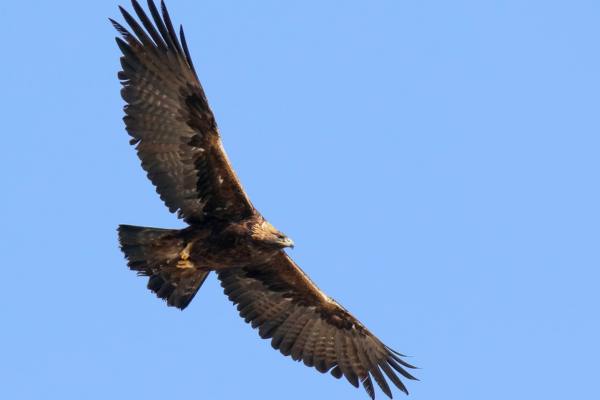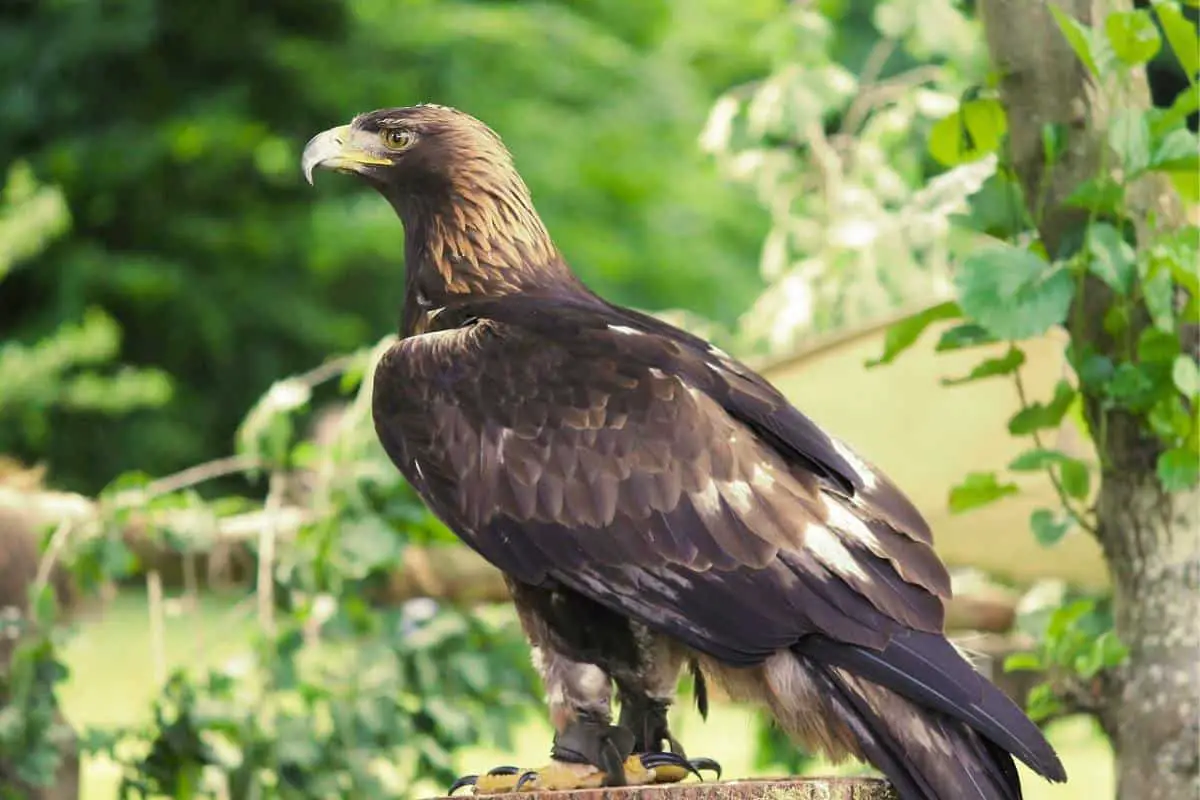Common Name: Northern Harrier
Scientific Name: Circus Hudsonius| Size | Diet | Range in Hawaii | Status in Hawaii |
|---|---|---|---|
| 30 in. - 40 in. | rabbits, hares, ground squirrels, and foxes | Kaua'i | Least Concern |
The Golden Eagle (Aquila chrysaetos) is one of the most iconic birds of prey in the world. With its powerful build, impressive wingspan, and striking golden feathers, this eagle has captured the imagination of people for centuries. Although it is native to North America, Europe, and Asia, it has also been spotted in Hawaii, making for a rare and exciting sighting for bird enthusiasts on the islands. In this blog, we’ll explore the fascinating world of the Golden Eagle and learn more about its unexpected presence in Hawaii.
Golden Eagle
Appearance

The Golden Eagle is an awe-inspiring creature with a captivating appearance. With a length of around 30 to 40 inches (76 to 102 centimeters) from head to tail, and an impressive wingspan of 6 to 7.5 feet (1.8 to 2.3 meters), it commands the sky with a regal presence. Its signature feature is its luxurious golden-brown plumage, which shimmers in the sunlight, earning it its name.
The adult Golden Eagle boasts a dark brown body with a distinctive golden hue on its nape and crown, creating a striking contrast. Its powerful, curved beak and piercing, intense eyes add to its commanding visage.
Diet
As a formidable predator, this majestic bird has a varied and opportunistic palate. Its diet consists primarily of small to medium-sized mammals, including rabbits, hares, ground squirrels, and even foxes. Additionally, it also feeds on birds, reptiles, fish, and carrion, showcasing its adaptability and scavenging abilities.
Nesting
The nesting behavior of the Golden Eagle is a testament to its dedication and strength as a parent. These magnificent birds construct large and sturdy nests known as eyries, usually perched on cliffs or in tall trees. The eyries are meticulously crafted with sticks, grass, moss, and other available materials, providing a secure and comfortable home for their young.
Golden Eagles are monogamous, forming long-term pair bonds. They typically return to the same nest site year after year, adding to and refurbishing the nest each breeding season. Over time, these eyries can become enormous structures, sometimes reaching several feet in diameter and weighing hundreds of pounds.
The female Golden Eagle lays one to three eggs, and both parents take turns incubating them for about 40 to 45 days. Once the chicks hatch, they are cared for diligently by both parents. The adults provide a steady supply of food, ensuring the chicks grow and thrive. As the young eagles develop, their downy feathers are replaced by darker plumage, and they begin to exercise their wings in preparation for their first flights.
Behavior

These magnificent birds are known for their regal flight patterns, soaring effortlessly on thermal updrafts while scanning the landscape for potential prey. Golden Eagles are solitary creatures, preferring to hunt and live on their own or in pairs. They establish large territories, fiercely defending their domain from other eagles or intruders.
Their hunting techniques are nothing short of remarkable, employing stealth and agility to surprise their prey. With remarkable eyesight, they can spot small mammals or birds from incredible distances, swooping down with incredible speed and precision.
While Golden Eagles are apex predators, they also demonstrate scavenging behavior, feasting on carrion and taking advantage of available food sources. This adaptability allows them to thrive in diverse environments, from rugged mountainous regions to open grasslands.
During the breeding season, the Golden Eagles engage in captivating courtship displays, performing aerial acrobatics and vocalizations to attract a mate. Once paired, they form long-term bonds and work together to build and maintain their nests.
Habitat

These magnificent birds are found in a wide range of habitats, from remote mountainous regions to vast open plains, and even in arid desert areas. They are highly adaptable and can thrive in different ecosystems, including temperate forests, grasslands, tundra, and even coastal areas.
Range
The Golden Eagle, a species primarily found in circumpolar regions of the Northern Hemisphere, had a notable occurrence in Hawaii. A single individual was observed on the island of Kaua’i from 1967 to 1984. This record represents the only known occurrence of the species in Hawaii, making it an exceptional and significant range extension for the Golden Eagle.
Conservation Status
The conservation status of the Golden Eagle highlights both its resilience and the ongoing challenges it faces. Globally, the species is classified as “Least Concern” by the IUCN, indicating a relatively stable population. However, regional populations may vary in their conservation status.
Interesting Facts
1. Acrobatic flyers
These birds are skilled aerial acrobats. They perform spectacular courtship displays, showcasing their agility and grace through impressive mid-air somersaults and cartwheels.
2. Excellent eyesight
Golden Eagles have remarkable vision, allowing them to spot small prey from great distances. Their eyesight is estimated to be at least six times better than that of humans.
3. High-altitude soaring
Golden Eagles are known for their ability to soar at great heights. They have been observed flying as high as 10,000 feet (3,048 meters) above sea level, utilizing thermal updrafts to gain altitude and cover vast distances.
4. Cultural significance
Golden Eagles hold cultural significance in various human societies. They are revered and symbolize power, strength, and majesty in many indigenous cultures and are often featured in myths, folklore, and traditional ceremonies.
5. Speedy descents
Golden Eagles are known for their impressive diving speeds. During hunting, they can stoop or dive at incredible velocities, reaching speeds of up to 150 miles per hour (240 kilometers per hour) as they close in on their prey.
Frequently Asked Questions
1. How long do Golden Eagles live?
Golden Eagles have a relatively long lifespan, with individuals living for 20 to 30 years on average in the wild. Some individuals have been known to live over 40 years.
2. Can I see Golden Eagles in the wild?
Golden Eagles can be observed in certain regions where they are present. However, due to their territorial nature and habitat preferences, sightings may be more common in remote or mountainous areas.
3. How do Golden Eagles hunt?
Golden Eagles are skilled hunters. They typically hunt by soaring at high altitudes, scanning the ground for prey. Once they spot a potential target, they dive down swiftly and use their powerful talons to seize and subdue the prey.
4. What are the vocalizations of Golden Eagles?
Golden Eagles are generally silent birds, but they do produce a range of vocalizations. These can include high-pitched whistles, shrill cries, barks, or chattering sounds. Vocalizations are often used during courtship displays or to communicate with their young.
5. Can Golden Eagles be kept as pets?
Golden Eagles are not suitable as pets due to their large size, specialized needs, and requirements for extensive space and appropriate environmental conditions. It is also illegal in many places to keep Golden Eagles without proper permits or licenses.




